Do you also get hungry when it comes to Italian pasta? In the early 1940s, a famous Italian writer said that the Italians owed the unification of the country to the invention of pasta. Another Italian writer, the founder of the futurist movement, claimed that pasta was Italy’s religion of gastronomy (“… la dine gastronomica italiana”).
Indeed, only the common love of pasta unites people from north to south as strongly as a religious belief. With its simplicity and modesty, pasta is a traditional value of immeasurable importance, as one of Italy’s most important cultural symbols.
The history of pasta dates back to Greek civilizations.

Pasta’s history dates back to the Greek civilizations Magna Grecia and Etruria, where in 60 BC the philosopher Cicerone spoke of the lasănum, a large pot that gives the current lasagna its name. Despite this, the invention of pasta, 12. It is associated with the Arab rule of Sicily at the turn of the century. The Arab geographer Edrisi speaks of a type of food made from flour, which has a long, thin shape called a tyriah. But in fact, pasta entered the country’s social culture with the return of Marco Polo from China in the early 1200s.
After famine, pasta becomes popular.
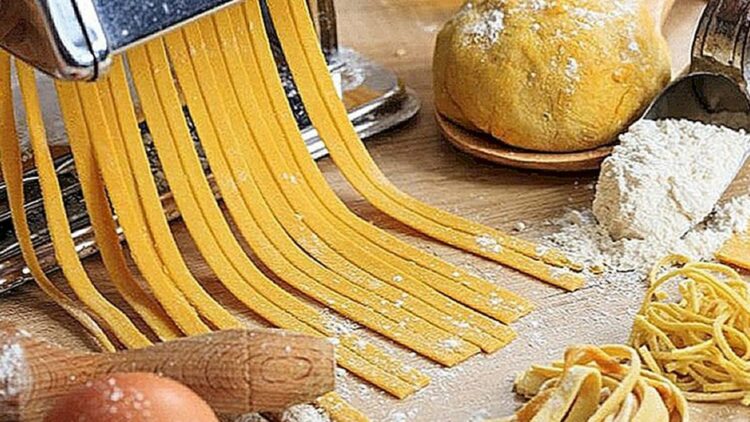
Interestingly, pasta is 17. It became popular after the famine that broke out in the Kingdom of Naples in the 19th century. The population is starving, and because they can no longer buy meat, they start eating cheap and plentiful pasta.
Pasta, from the south of Italy, spreads to the whole country in a short time, adapting to the ingredients and foods specific to each regional cuisine. Many of the world-famous pasta dishes are actually traditional dishes of Rome. It’s hard not to think about the iconic scene in the 1954 film “Un Americano a Roma” where Alberto Sordi swallows a huge plate of Maccheroni.
So let’s see what are the most popular pastas in Italy. If you want to learn about the best Italian pastas, this list is for you… The 40 most famous Italian pastas, both with what you know and what you don’t know…
Italian Pastas
1) Tortellini

The first type of pasta on our list of Italian pastas is tortellini. A type of pasta similar to Turkish ravioli, made with various ingredients that are securely wrapped in a layer of egg pasta and then folded into a ring. It is claimed that a cook who saw the goddess Venus, inspired by her belly button, gave this shape to the pasta.
The first written record of Tortellini is in the 17th century. goes back to the century. However, it is possible that it was consumed before that. It is believed that they came from the Emilia-Romagna region, especially from the cities of Modena and Bologna. Unlike other types of pasta, tortellini was considered a luxury dish, often served at hotels or festivities. This type of square or round filled pasta is made with many different fillings, such as meat, vegetables, and cheese, depending on the recipe. One of the most famous varieties is the one with cottage cheese and spinach.
2) Spaghetti

Spaghetti, translated as ‘thin threads’, is one of Italy’s most iconic pasta shapes. It is a type of pasta made with water and hard wheat, long, thin and usually prepared with tomato sauce and cheese. They are cylindrical strips about 30 cm long, known for their use in Carbonara or Puttanesca.
Spaghetti is suitable for lighter and less dense sauces, as it is not made to preserve the sauce like other pastas. The classic spaghetti “aglio e olio” is a classic example of this. Also, keep in mind that spaghetti is never used with bolognese sauce (ragù)!
3) Penne

When it comes to Italian pasta, the first thing that comes to mind is penne. The origin story of this pasta is also associated with the emergence of the pasta machine. Penne originated in 1865 in the small town of San Martino d’Albero, near Genoa, with a new device patented by Giovanni Battista Capurro. The machine shows that pasta tubes can be cut diagonally to a standard size and there is no need to use scissors as was done before.
While there are different types of penne, the most common is penne rigate and of course penne all’arrabbiata. The indentations in the penne help the pasta hold the sauce, while the pasta has a firm enough texture to be paired with larger chunks of vegetables.
4) Ravioli

The word ravioli refers to various types of pasta made by putting a filling between two thin layers of dough. Turkish ravioli is the Turkish equivalent of Ravioli. The pasta used is typically wheat flour and egg-based and is bound with the sauce or broth in which the ravioli is cooked or served while also acting as a casing.
Ravioli are served in broth, often simmered with a sauce or simply boiled as a traditional winter dish. Ravioli fillings contain a variety of meat, cheese, and vegetable varieties and vary from region to region. There is also deep fried sweet Ravioli.
5) Tagliatelle
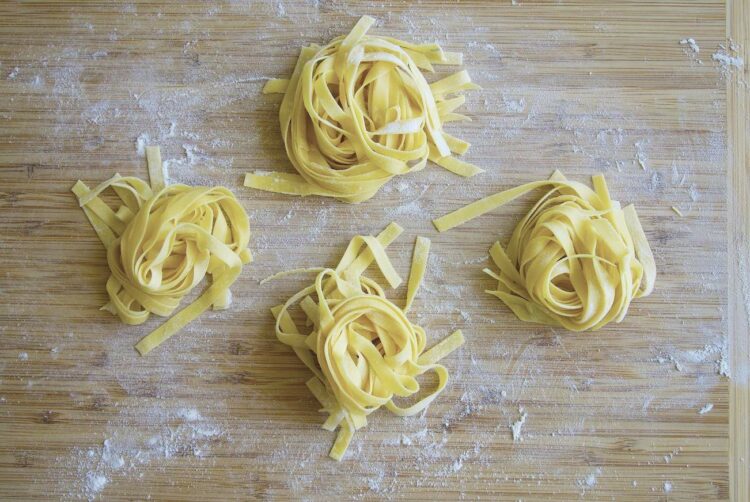
Tagliatelle, another variation on our list of Italian pastas, has an interesting history. These flat pasta strips century Bentivolgio II. He is thought to have been born at a special banquet organized by Giovanni. This feast is held to celebrate Lucrezia Borgia’s visit to Bologna on her way to Ferrara in 1487 to marry the Duke Alfonso D’Este.
The head chef of the Bentivolgio family takes plates of pasta (used in Bolognese’s staple lasagna) and cuts them into ribbons, supposedly to pay homage to Lucrezia Borgia’s wavy blonde curls. Regardless of whether this legend is true or not, tagliatelle has survived to this day as one of Italy’s favorite pasta dishes. With a flat surface and a width of about 6-8mm, this pasta is ideal for meat-based sauces such as beef and pork.
6) Lasagna

Lasagna, which is the subject of even cartoons among Italian pastas, is a type of pasta with its own subgroup that creates many delicious dishes. The earliest information regarding the history of lasagna is that it derives its name from the Greek word laganon, which refers to a flat sheet of dough cut into strips.
There is also another Greek word, lasanon, which refers to an ancient crock pot. The Romans adopt this word and transform it into lasanum, also referring to the cooking pot.
7) Linguine

The name of this flat, thin Italian pasta variety literally translates as “little tongues”. Also known as trenette or bavette in Italy. Linguine is made from wheat flour and water. It is typically served as a pastasciutta with traditional Ligurian sauces.
It is sometimes boiled together with potatoes and green beans. It is served with pesto alla genovese and is also often paired with fish-based sauces. In Lipari in the Sicilian archipelago, linguine is traditionally served with tuna and capers. It is truly a versatile pasta, can be used in many dishes and is compatible with many flavors, making it one of the most popular types of pasta outside of Italy.
8) Fettuccine

Literally translated as little ribbons, fettuccine is a classic Italian pasta made with wheat flour, salt, eggs and some water. Factory-made fettuccine is usually made by adding wheat flour, eggs, and sometimes water.
This type of pasta is a specialty of central and southern Italy, especially Lazio. According to the classic recipe, fettucine should ideally be cut as wide as a finger. But modern fettucine is typically narrower than that.
9) Macaroni

Macaroni is a dry, short type of pasta made with wheat and water. In northern Italy it is usually a variation of tubular pasta, a category that is also accepted in many other parts of the world.
The word “maccheroni”, formerly Italian, was a generic name used to refer to all types of dry pasta known today as pasta “secca”. The known origin of Macaroni goes back to Naples.
10) Cannelloni – Naples

This tube-shaped Italian pasta variety was made in the 1907s by Nicola Federico, a Neapolitan chef who worked at a popular restaurant called La Favoria in Sorrento. Originally called strascinati, pasta was made during World War II. It was renamed cannelloni after it gained popularity due to the influx of people from Naples to Sorrento during World War II.
Cannelloni are usually stuffed with meat, cheese or vegetables, then cooked in tomato or cream-based sauces. Pasta pairs well with meats such as beef, pork, and veal, cheeses such as mozzarella and ricotta, vegetables such as carrots, spinach, and celery, as well as a variety of sauces, herbs, apples, and walnuts.
11) Ditalini

The other variation on our list of Italian pastas, this small, tube-shaped pasta has a slightly nutty flavor and firm texture. Ditalini is most commonly consumed in the Italian region of Campania, where it is traditionally used in pasta e fagioli, minestrone and other soups. With its small size, it also achieves a perfect harmony and flavor with broth-based soups.
This pasta comes in a smooth and ridged variety known as ditalini rigatti. The name Ditalini can be literally translated as small thimbles. Ditalini is also often used in pasta salads. For this reason, it is also called salad pasta in some regions.
12) Vermicelli

Vermicelli is a type of Italian pasta made from fine noodles, made from flour, eggs and some salt. 14. It originates in Italy in the 19th century. The wire noodle we have is thin. They are sometimes called vermicelli (small worms) because they are as thin and slender as the tiny worms found in cheese.
In the summer, young peasant girls made enough vermicelli for the whole year and dried the pasta in the sun to make it last longer. Noodles are slightly thicker than spaghetti, but in the United States it’s the opposite.
13) Bucatini

The next pasta on our Italian pasta list is bucatini. It is a type of long, narrow, tubular pasta that resembles spaghetti. Pasta is characterized by its chewy and dense texture.
The name Bucatini is derived from the Italian word buco, meaning hole, referring to its hollow shape. The origin of Bucatini is believed to be in Central Italy, around Rome. It pairs well with solid, hearty sauces, especially with the classic amatriciana sauce made with tomatoes and guanciale.
14) Fusilli
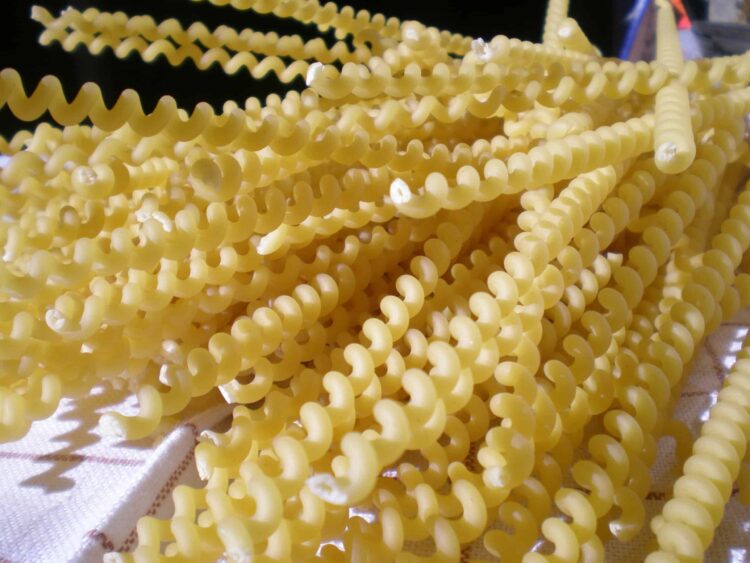
Fusilli, Italy’s third favorite pasta shape, is actually the auger we all know. This type of pasta with a short, twisted shape can be found in many recipes from the southern regions of Italy. Named after a tool for spinning wool (“fuso”), this type of pasta is perfect with meat or ricotta-based sauces.
15) Rigatoni
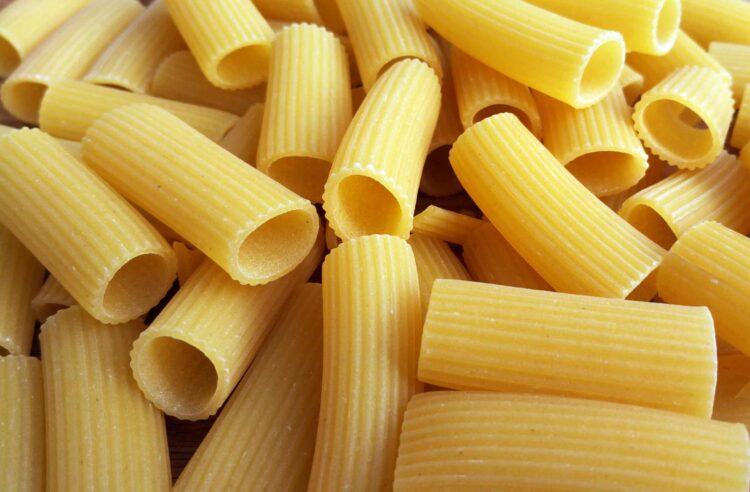
Rigatoni gets its name from the ridges on its broad, cylindrical surface; It is derived from the Italian rigato, meaning protruding. This type of pasta is originally of Roman origin. However, it is associated with southern and central Italy and is a favorite of Sicily. Due to their large size, they are often used in baked dishes such as rigatoni and casseroles, but are ideal for dishes with tomato sauce. These short tubes of pasta are favored in Southern Italy, where they are often paired with thick sauces. Similar to penne, sauces that can hold vegetables and meat pieces go well with this type of pasta.
16) Farfalle

It is a very beautiful pasta type in terms of aesthetics and also a very popular pasta type in Italy due to its butterfly-like shape. But be careful while cooking, because the middle of it may be hard or the wing parts may become too soft due to the butterfly shape. It dates back to the 1500s and was first made in Italy’s Lombardy and Emilia-Romagna regions. Farfalle is ideal for heavily flavored dishes and goes well with oil-based sauces and light sauces with fish or vegetables. It can also be added to pasta salads.
17) La Carbonara Pasta

Another flavor of our Italian pasta list is la carbonara. With a creamy consistency, delicious smoky and peppery flavor, Carbonara is the number one pasta dish both in Italy and outside of Italy! Although known to be originally of Roman origin, the Carbonara may have come from woodcutters living in the Apennines who cooked their pasta over charcoal fire. Hence its name is derived from carbon (coal).
18) Cacio e Pepe

Cacio e Pepe is another gastronomic symbol of the Italian capital; It is a simple but incredibly satisfying dish made from two ingredients. Most notably, Cacio cheese and peppers, with a small amount of cooking water added to the sauce to give it flavor. It reaches a creamy consistency and melts in your mouth. American chef Anthony Bourdain went so far as to say that Cacio and Pepe might be “the most glorious thing in the history of the world”.
19) Sagne
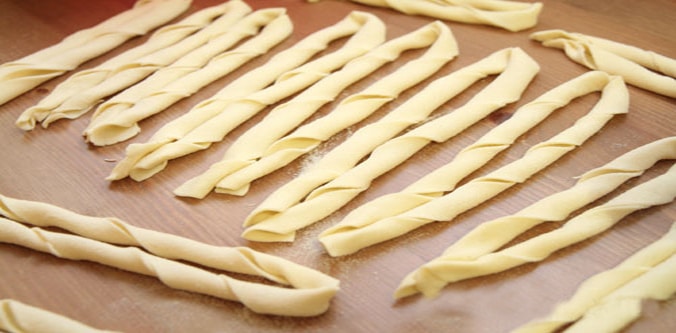
Sagne is a rustic Italian pasta dish originating from the highlands of Abruzzo, Molise and Lazio. Pasta is traditionally made with just wheat and water. Today, however, eggs are added to the dough, which is cut into rectangular shapes resembling short tagliatelle.
It is usually served with borlotti beans or peas (cicerchie). In Lazio, cannellini beans and wild asparagus are served, while in Abruzzo the pasta is served in tomato and bean juice or with garlic, chickpeas and herbs, but no tomatoes.
20) Orzo

Not to be confused with the Italian word for barley (orzo), this Italian short-cut pasta is similar in shape and size to a grain of rice. Like other traditional Italian pasta types, it is preferred to be made with hard wheat. The shape of orzo pasta is always the same, but the color and taste are sometimes changed with the addition of various vegetables. Orzo is a versatile type of pasta used in numerous dishes. Its shape is especially suitable for soups and is an indispensable part of minestrone soups. Orzo pasta is also commonly used in cold salads, as a vegetable filling, and in various casseroles.
21) Pappardelle – Tuscany

Pappardelle is a type of Italian pasta characterized by the size of its large, flat noodles. Traditionally, pappardelle is made with an egg-based dough. This makes the pasta richer and tastier. Its origins are attributed to the Central and Southern regions of Italy, such as Tuscany, where pappardelle is widely used in the preparation of many traditional dishes. The name of the pasta is derived from the Tuscan word pappare, meaning to eat with childlike delight. Pappardelle is paired with dense and hearty meat sauces or ragus.
22) Conchiglie

Conchiglie, another pasta on our list of Italian pastas, is a variety characterized by its shell shape. There are three main sizes of conchiglie: small (conchigliette), ideal for soups, regular conchiglie, best for stuffing or cooking, and jumbo (conchiglioni). Although it is mostly sold in the plain variety made from durum wheat, there are also varieties colored with tomato, spinach or squid ink. Conchiglie pasta is known to hold chunky and meaty sauces exceptionally well. Therefore, it is recommended to pair it with meat dishes, sauces and vegetables, preferably with a little grated Parmesan or Pecorino cheese.
23) Orecchiette – Apulia

This Italian pasta variety is characterized by its shape resembling small ears. Their shape gives them a unique texture that is soft in the center and slightly chewy at the edges. Orecchiete was founded in the 8th century, when the region was under Norman-Swabian rule. It is made in Puglia in the 19th century, and some food historians think it was designed by analogy with the roofs of traditional cone-shaped huts called trulli built in the region. Orecchiette pasta is usually served with tomato sauce, meatballs, ricotta cheese or broccoli.
24) Paccheri – Campania

Paccheri is a type of Italian pasta characterized by its large, tubular shape. Originally, paccheri pasta was used as a vehicle for smuggling banned garlic cloves from Italy to Austria. Because the Prussian garlic was small and weak, and the Italian garlic was big and tasty. Today, paccheri is often stuffed with sausage, garlic, and mushrooms, or served with dark, meaty sauces like ragù alla Bolognese. Pasta can be used in the preparation of casseroles filled with ricotta and topped with tomato sauce and cheese.
25) Rotini

Rotini is a type of pasta originating in Northern Italy, characterized by its thickness and screw-like shape. Rotini spirals and twists make it an ideal pasta for holding both solid and simple sauces based on tomato, dairy or oil. This pasta is often used in dishes such as pasta salads and carbonara. The word rotini means small wheels, referring to the many spirals in its shape.
26) Cavatappi
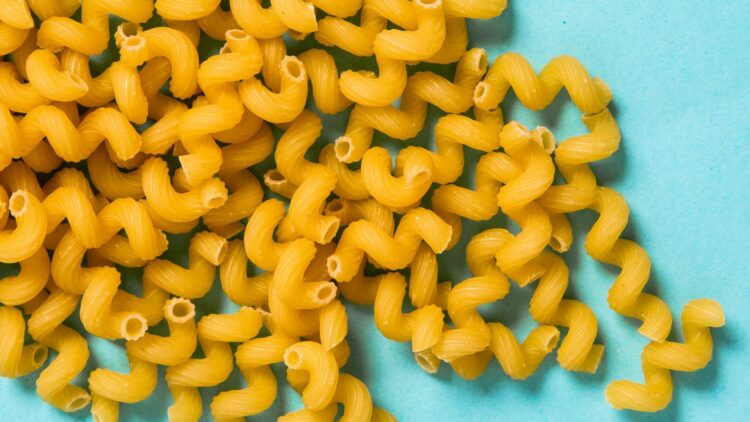
Cavatappi is a thick corkscrew-shaped Italian pasta. It is usually protruding on the outside. That’s why it’s great for holding chunky sauces. Pasta is also often used in baked dishes and to prepare cold pasta salads. The name of the pasta means corkscrew, referring to its unique and unusual shape.
27) Cavatelli – Apulia

Cavatelli is a kind of Italian pasta made of semolina flour and warm salt water. Although its history is uncertain, it is known that cavatelli came from the south and was made in Puglia, Calabria and Basilicata. Cavatelli is initially paired with modest sauces consisting only of oil and garlic. However, today it is also used with various sauces such as olive, arugula and cream.
28) Capelli d’Angelo

Capellini is a type of Italian pasta that, although it holds its shape extremely well when cooked, is long, very thin and almost brittle in texture. The name capellini means fine hair or children’s hair, referring to thin strands of pasta. It is recommended to use capellini in broths and soups, or in combination with thin sauces or seafood dishes.
29) Trophie

Trofie is a type of handmade pasta dating from Liguria to the Crusades. It is traditionally made with wheat flour and water. Then a small piece of dough is rolled and shaped on a flat surface. The dough is then bent to take its final shape. Trofie is usually served with pesto sauce. The word trofie is derived from the word strufuggiâ, meaning to rub, referring to the production method.
30) Campanelle

Campanelle is a delicate, short and firm pasta variety from Italy, characterized by a hollow center and corrugated edges resembling leaves. The center is especially well designed for catching sauces. This is why bellflower is often paired with hearty sauces like bechamel or vegetable-filled chunky sauces.
A versatile pasta type, campanelle also pairs well with meat, fish or tomato sauces. The name Campanelle means bellflower, referring to the shape of the pasta.
31) elicoidali

Elicoidali is a medium-sized Italian pasta, similar to rigatoni. It is made in the form of tubes with spiral protrusions on the outside, which helps the sauce adhere to the pasta, providing extra flavor to consumers in every bite. Pasta is often used in pasta salads or baked dishes such as casseroles.
32) Strozzapreti

The other variety on our list of Italian pastas is strozzapreti. It is a handmade, twisted pasta made throughout Italy, especially in the regions of Tuscany, Marche, Umbria and Emilia-Romagna. This rustic pasta usually consists of a combination of wheat flour, semolina flour, water and sometimes eggs. It pairs well with solid, firm sauces, whether vegetable or meat-based. The name Strozzapreti means priestly choker or priestly choker, referring to its twisted, strangled shape.
33) Garganelli

Garganelli is a unique Italian type of pasta made with flour, eggs and water, characterized by its method of preparation. Pasta is made by rolling a flat, square noodle into a tubular shape with a pencil-sized wooden twig, pressing protrusions on the outer surface of the dough during the process. Garganelli is believed to have made it in 1725 in the Romagna region. Originally pasta was served in broth, but today it is often paired with prosciutto and peas, creamy sauces or rich chunks of meat.
34) Casarecce

Casarecce is a type of Italian pasta originating from Sicily. The casarecce’s long curves seem to be rolled up on itself, making it the ideal pasta for holding both robust, traditional sauces and simple sauces. It can also be used in a variety of casseroles, as the pasta is less likely to be too dry. The name Casarecce means homemade.
35) Manicotti

The other flavor of our Italian pasta list, manicotti is characterized by its tubular shape and protruding texture. This makes it ideal for thick sauces and hearty fillings. It is one of the oldest forms of pasta in the world, made with semolina flour and water, with the occasional egg added.
Sauces can be meat-based, dairy-based, or vegetable-based. But it is also possible to stuff manicotti with ingredients such as spinach, ground beef or various cheeses.
36) Cappelletti

Cappelletti is a type of Italian pasta prepared in the form of a hat. Initially, pasta was preferred with boiled beef, Parmigiano-Reggiano and selected spices. Today, pasta is mostly stuffed with meat and cheese. It is often served in chicken broth, especially on festive occasions such as Christmas and New Year’s Eve. Cappelletti, which has a history dating back to the Middle Ages, is usually preferred as a luxury meal or in rich menus.
37) Fagottini

Fagottini is Italian pasta made from a dough shaped into a ball or small pouch, usually stuffed with ingredients such as ricotta cheese, carrots, green beans, truffles, or pieces of fresh pears. The name fagottini means small bundles, referring to the shape of the pasta. It is recommended to pair fagottini with thin sauces. But it can also be served in various broths.
38) Bigoli

Bigoli is a long Italian pasta variety characterized by its thickness and rough surface. It was originally made with buckwheat flour, but nowadays it is usually made with whole wheat flour, butter, a small amount of water and sometimes duck eggs. Pasta is traditionally prepared using a press called the bigolaro, which dates back to 1604. Whole wheat flour gives bigoli an earthy taste and pleasant texture. Its texture, prepared with buckwheat, makes the bigoli stick to the sauce more than other types of pasta.
39) Passatelli

Passatelli is a type of pasta made of breadcrumbs, egg, salt and Parmigiano Reggiano cheese. Nutmeg and grated lemon peel are also often used in the preparation of this type of pasta. It is traditionally made by passing the dough through a potato grinder into a broth, usually simmering. The pasta is then served in soup bowls and it is recommended to finish the meal with more grated Parmigiano Reggiano.
40) Calamarata

The last flavor on our list of Italian pastas, calamarata is cut into a thick ring. It is made from durum wheat flour and is sometimes colored with squid ink to resemble sliced squid. Pasta is often used in a dish called calamarata Napoletana, where it is combined with seafood such as squid, oysters, and shrimp.














